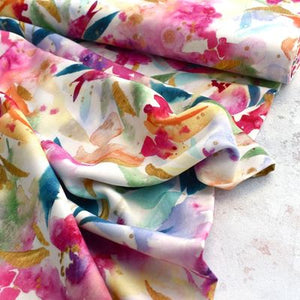Rayon wovens are the fabric of choice for super swishy skirts, drool-worthy draped dresses, and blouses with flounce. All of those beautifully airy, silky smooth yards of material can quickly turn into a bunch of very ugly words hurled at your project-to-be as the slippery nature of this semi-synthetic fiber can frustrate even the most zen of sewists. Here are a few helpful tips to hopefully make working with rayon wovens and your sewing life a bit easier!
1. Wash with Care.
While the best way to care for rayon is dry cleaning, if you choose to wash it, use cold water on delicate/hand wash, and always avoid the dryer. Also, always ensure it’s fully dry when you begin working with it; rayon can lose strength when wet.
2. Dream Team: Pattern Weights + Rotary Cutter.
The slippery nature of rayon wovens makes them a dream to wear,= but a nightmare to cut! To avoid watching your fabric slip-sliding away from you, put down the scissors and pick up your handy rotary cutter and something to weigh that fabric down for stability. If you don’t have pattern weights, coffee mugs, canned goods, or mason jars all work too!
Sew Smart! If you still find yourself fighting with slippery rayon fabrics, try temporarily stiffening them with spray starch, a gelatin/water bath, or another liquid stabilizer. Be sure to test a sample before applying it to the rest of your fabric.

3. Slow Sewing
Take time to test the settings on your sewing machine (and serger) with a few scraps of your fabric. You may find you want a small stitch length or want to change how you finish your seams, depending on how the fabric behaves. If you have one, a walking foot may prove helpful to feed the layers of fabric more evenly. Stitch slowly, avoid pushing/pulling, and make adjustments as you go!
4. Pin, Pin, Pin.
Even if you are someone who rarely uses pins in the construction of your other sewing projects, you are better off bringing them out for any rayon-based garments. This shifty fabric will find a way to move around on you more than you’d expect, so be generous with how many pins you use. If possible, it is best to use fine-tipped pins, like those meant for silk; rayon can snag quite easily, so the pointier the pins, the less likely that is to happen.
5. Size Matters.
Always use a microtex or sharp needle (the smaller size, the better) in your machine when sewing rayon. As we mentioned in Tip #4, this snaggable fabric can also easily get holes in it if the needle is too large.

6. No Shortcuts!
Though stay-stitching is among those thankless sewing tasks that feel like they prevent you from getting to the “good stuff” sooner, we are making an official plea that you NEVER skip this step! Skipping this admittedly tedious task is not the shortcut you want to take on shifty, light-weight fabrics, like rayon, that easily stretch and lose their shape as you handle them. This is especially important on necklines and other curved or bias cut areas.
7. Planning Ahead
When thinking about which size to make your garment, remember that rayon shrinks a bit each time you wash it. This may not affect patterns with plenty of ease, but for more fitted garments, you may want to consider this possibility and plan accordingly. This is especially important when determining lengths. Try adding a bit extra and sew a larger hem for now, and future you will appreciate the consideration later!
8. Escape the Fray.
If being shifty wasn't enough, the thin nature and lack of stretch make rayon woven fabrics somewhat delicate. This can cause the fabric to become weak or frayed in areas where there may be more stress or repeated strain. Pay close attention to areas such as knees, elbows, shoulders, and hips to ensure you’ve got room to move and groove for years to come without bursting a seam! You may also want to reinforce or sew larger seam allowances near zippers and other closures for added strength.
9. Keep Your Cool.
Rayon fibers can take on a shiny cast when pressed for too long or with an iron that is too hot. Your best bet is to set the temperature on your iron to a low or medium setting and always use a press cloth. It also doesn't hurt to press with the wrong side up whenever possible. Remember, we want YOU to shine in your rayon garment, not the garment itself!

10. Let's Hang Out
After finishing most of your garment, we recommend that you "hit pause" before sewing the final hem. Delicate fabrics, like rayon wovens, can “grow” and stretch, so it is best to always hang your garment and let it relax for a day or so before hemming. This way, you can sew a truly even hem after the fabric has settled. You’d be surprised at how much that perfectly straight hem develops a wave to it after only a day!
Sew Smart! Want a bit of extra help with sewing your hems? Try a wash-away or ultra-light interfacing tape for a perfect hem every time!







What is the best interfacing to use on Crinkle Cotton?
Thanks
(360) 572-2281 PO Box 3762, Arlington, WA 98223 http://www.stylemakerfabrics.com/ http://mailto:info@stylemakerfabrics.com On Sun, 28 Jul 2024 14:35:43 0700 Sunny@comment.sunnysideapps.com <sunny@comment.sunnysideapps.com> wrote --———
Style Maker Fabrics replied:
A lightweight woven or tricot interfacing would work well with the Crinkle Cotton. For more structure you could also use a medium weight interfacing.
I have the same question as Shirley as I am currently obsessing over a fabric identified “rayon poplin” and wonder if this is any less difficult to sew than rayon.
Can you identify the pattern used for the yellow dress in your post? It’s on a dress form and has an interesting ruffle (under your step #9)
(360) 572-2281 PO Box 3762, Arlington, WA 98223 http://www.stylemakerfabrics.com/ http://mailto:info@stylemakerfabrics.com On Wed, 29 May 2024 14:55:55 0700 Sunny@comment.sunnysideapps.com <sunny@comment.sunnysideapps.com> wrote --———
Style Maker Fabrics replied:
Hello, that photo is actually a stock photo. It’s not a pattern that we sell in the shop, unfortunately.
Thank you so much for the tips!
I second Shirley’s comment, when I last sold 20 25 years ago there wasn’t rayon poplin and all that, just rayon challis
Leave a comment